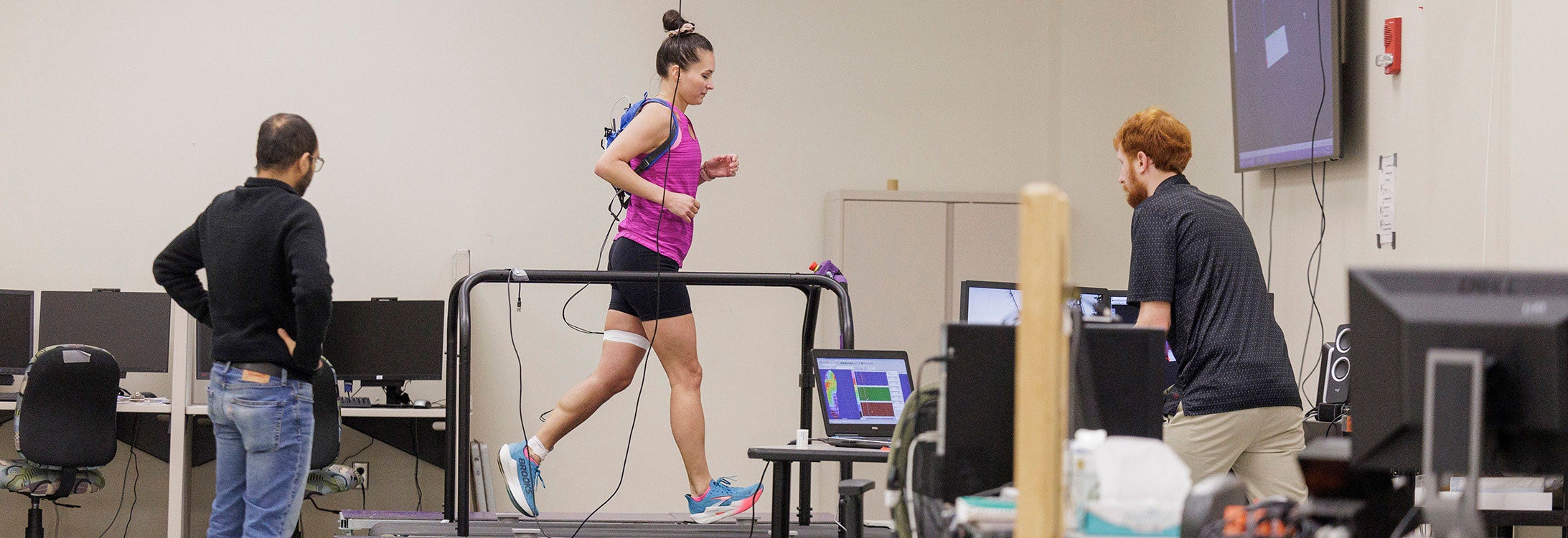New research unveils insights on carbon-fiber shoes and foot health
The sports world is built on finding the next advantage to win the big game, break the finish line tape and win a medal. For runners, advantages are usually incremental, at best.
Until the advent of the carbon-fiber revolution, giving elite runners a fractional, but measurable, leg up on races. While technology is increasingly giving the general running public the same advantages as world-class athletes, little is known about what is happening with the runner’s foot inside the shoes.
Until now.
East Carolina University’s Ankur Padhye, a doctoral student in the College of Allied Health Sciences’ Department of Physical Therapy, is using cutting edge technology, and cutting up very expensive shoes, to get an understanding of what is happening with the bones, muscles and ligaments of those wearing carbon-fiber kicks.
A Born Scientist
Padhye grew up measuring things.
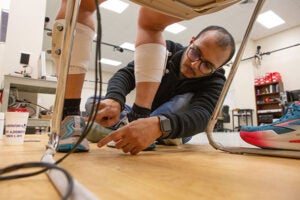
Physical therapy doctoral student Ankur Padhye attaches reflective markers to a research study participant’s foot. (Photo by Benjamin Abel)
His father, a zoologist who studied frogs near their home on India’s west coast near Mumbai, roped Ankur into his research.
“I went on field trips collecting frogs, measuring their feet and everything. I guess trying to find answers with the data on graphs was always my thing,” Padhye said.
In high school, he considered medical training but knew a doctor’s work-life balance could be harsh. During his undergraduate education he represented his university playing badminton and cricket, never great at anything, Padhye said, but “decent at everything.” The mix of medicine and knowing the need for injury prevention treatment and research made physical therapy a natural fit for his graduate education.
After graduating with a master’s degree in physical therapy from the University of Indianapolis, Padhye took a job at a clinic in Kinston. The work was rewarding, but the spark he got early in life from fundamental science — learning new things for the first time — was missing. When he was accepted at ECU as one of the physical therapy department’s doctoral students, he was able to pursue pure science while working with patients, a perfect blend of his interests.
Why the Research?
Padhye knew early that the central focus of his research would be injury prevention, but he noticed during his time working with patients that the basic science findings from physical therapy research labs lagged too much. Findings that could prevent injury or speed recovery were getting hung up.
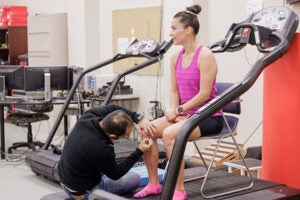
Physical therapy doctoral student Ankur Padhye marks bony locations on a study participant’s leg before starting a run on the treadmill.
Could he find a way to evaluate emerging science and quickly bring those findings to practitioners in clinics and hospitals?
The question was where to begin.
Most research on stress loads has been limited to studying cadaver feet or using sensitive mats that register how bare feet land on the ground.
“But that’s not really how most people do our tasks like running. Not many people run barefoot in a marathon,” Padhye said.
After consultation with his mentors in the physical therapy department, Drs. John Willson and Stacy Meardon, Padhye was intrigued by the possibilities in a niche research area of forefoot mechanics. The foot had been studied, of course, but the hard part was knowing what was happening with the bones, tendons and other parts when a person is wearing a shoe.
“I found out there’s not much going on research-wise because it’s complicated to come up with simple yet effective solutions to get answers to what’s exactly happening at the joint,” Padhye said.
Research has been done around how carbon-fiber shoes running shoes increase performance —VO2 max and exertion levels — but what actually happens under the skin, where bones meet and tendons hold everything together, was still something of a mystery. Almost nothing was known.
How do you “see” inside of a shoe, particularly when it is being worn?
A common technique for studying how the body moves is to affix reflective markers to points of the body that special cameras can detect and replicate in a digital environment. For Padhye to get at the joints he needed to image, he had to strategically cut holes in the upper material of both the carbon fiber and control shoes to adhere the markers to participants’ feet.
Add some incredibly sensitive insoles connected to computers to an array of motion-capture technology like that used to create Hollywood sci-fi blockbuster characters, and Padhye and his team were off the races.
How the Shoes Work
A New York Times article on carbon fiber shoes discusses the technology’s development and use by elite runners as well as those looking for a leg up on race day. In short, the shoes offer a small, but not insignificant, advantage in terms of energy expenditure.
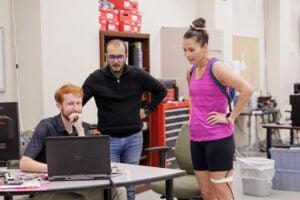
Physical therapy doctoral student Ankur Padhye and study participant Marina White look at results from a test session on the treadmill.
Traditionally, running shoe companies have played at the margins of technology to help runners gain an advantage: different foams for soles, air pockets in the heel, thick soles or barely any cushioning at all.
Carbon fiber is different. Manufacturers have incorporated a carbon-fiber plate into the sole of seemingly normal shoes. The plates make the shoes rigid, very difficult to bend in half by hand, but they give when worn. While running, the flexing process requires energy, which then creates a spring-like function when the carbon plate resumes its normal shape.
Carbon-fiber shoes have been shown to give wearers up to 4% increase in efficiency, meaning runners use less energy and can run faster. The first sub-two hour marathon was run in carbon fiber shoes, which has fueled considerable controversy since, but shoe manufacturers have gone all in on marketing carbon-fiber shoes to the general public.
“Previous studies were based on gas exchange. With these carbon-fiber shoes the amount of oxygen a runner inhaled, and carbon dioxide exhaled was X,” Padhye said. “And then without the shoes it was 4% more, something like that. So, the previous researchers said, ‘OK, these shoes help with energetics.’”
There is little doubt that the shoes increase performance, but Padhye wanted to know if the shoes prevent injury.
Dr. John Willson, a professor in the PT department and one of Padhye’s advisors, said at the heart of the study is learning the mechanics of wearing the new technology. Do the toes push off differently? Does the stability the carbon-fiber provides the foot insulate it from injury from repetitive stress? Or do the muscles work differently to propel the foot forward?
“There may be some real applications for people with foot and ankle injuries, and possibly even knee injuries,” Willson said. “Previous studies have just looked at the whole foot as a unit. What is causing the increase or decrease in propulsion forces? We’ll be able to separate those influences.”
Padhye and his team recruited a handful of local runners to their basement lab in the health sciences building, a cavernous space with a long wall lined with a showroom’s worth of treadmills. At one end is Padhye’s treadmill, ringed overhead with cameras and lights that record every step the runners in the study take.
One participant, 2007 ECU College of Nursing graduate Marina White, has been a neonatal intensive care nurse for nearly two decades. She started running several years ago and became enamored with seeing her personal improvements.
White said she’s a “nerd for science” and thought participating in the study could be a cool experience, plus learning about — and experiencing — the carbon-fiber technology without investing several hundred dollars was enticing.
On the morning of her evaluation, White was measured in slew of ways — height, weight, bone length, flexibility — before testing her calf endurance. After reflective markers were attached, she strapped on a backpack full of computer sensors and slipped her hot pink socked feet into a pair of modified shoes.
Once on the treadmill, Padhye and a fellow student began logging data coming from the pressure insoles in White’s shoes and the dots placed on the major joints in her body that showed in real time on a huge television screen on the wall.
After finishing her first run on the treadmill, White said she immediately felt the difference in the carbon-fiber technology.
“It was way easier this time. It was different; interesting that the shoe made such a difference. Running with the shoe felt springy, where before it felt flat, if that makes sense,” White said.
How Does This Impact the Public?
The hypothesis that Padhye is working from is that in addition to making runners faster, the carbon fiber shoes might also reduce loads on forefoot bones and joints.
Padhye said carbon-fiber shoes are currently not designed for everyday running.
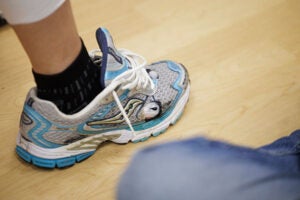
A modified shoe is worn by study participant Marina White prior to running on a treadmill during a study of the impact of carbon-fiber shoes on runner’s feet.
“All the big manufacturers say that the foam and plate interaction, especially the foam side, only has a maximum potential of 100 miles. So even if someone is using these as training shoes, they are probably not at their best efficiency after 100 miles,” Padhye said. “Plus, these are really high-end shoes that are very expensive, upwards of $200, so as of now, I don’t see these as a regular training shoe for everybody.”
But maybe the technology could be used for middle distance runners to reduce injury from the stress on the feet and legs of runners training for longer races. If runners are going to try these shoes for increased performance and potential injury prevention, Padhye cautions that they should train with them as the carbon-fiber shoes force a slightly different running style, which poses its own risk for injury.
“These shoes encourage a more rocking style so if someone wants to train to use these shoes, I think they should keep that in mind,” Padhye said.
Willson said research like Padhye’s is important to extend the foundational understanding of how the body works, but it is equally important for the future of teaching physical therapy students. While most PT students graduate and treat patients for the rest of their careers, Willson said he and fellow faculty members will one day age out of the classroom and will need to be replaced by skilled researchers.
“There’s a real need in the in the academic space for physical therapists who have their Ph.D. There are accreditation standards that dictate the composition of the faculty who teach in physical therapy programs and a certain percentage of faculty need to have a terminal academic degree,” Willson said.
